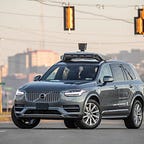A Principled Approach to Safety
At Uber, we believe that technology has the power to ignite opportunity by setting the world in motion. This is why we introduced the original Uber service in 2010. Today, you can get a ride using the Uber app in more than 600 cities across 65 countries on six continents and, in some places, you can use the Uber app to get a bike, a scooter, and connect seamlessly to public transit. It was this same confidence in the potential of technology that led us to establish our Advanced Technologies Group in 2015. We believe that introducing self-driving vehicles to the Uber network could make transportation safer, more efficient, and more affordable for people around the world. We also believe that our efforts to develop self-driving technology are consistent with our core value to Stand for Safety.
In the three years since we embarked on our self-driving journey, our experiences have taught us a few valuable lessons.
First, we know that the transition toward this technology will take time. It will take time because we are committed to creating high-performance technology through rigorous software and hardware development processes. It will take time because we are committed to developing this technology with input from the people who will benefit from its availability and with governments, nonprofits, and industry groups. This means not only gathering feedback, hearing concerns, and answering questions, but also sharing information on our progress, and seeking guidance from government stakeholders and other experts. For Uber, this is not a sprint: self-driving and human-driven vehicles will coexist on roadways for decades to come.
Next, we know that we can all benefit from this technology sooner by leveraging the depth and breadth of the Uber network and the experience that comes with running it. Our global network of more than 3 million driver and delivery partners enables approximately 15 million trips every day. These partners are the lifeblood of the Uber network, and they aren’t going anywhere. In the early days, self-driving technology will only be able to serve some trips in some markets. As we progress in our development and look to begin connecting riders with self-driving vehicles, we will only do so when it makes the most sense for that trip. Adding self-driving vehicles to our platform will increase the size and efficiency of the Uber network as a whole, rather than replacing trips.
Third, we know that this transition is not achievable without testing on public roads. We are committed to anticipating and managing risks that may come with this type of testing, but we cannot — as no self-driving developer can — anticipate and eliminate every one.
We are deeply regretful for the crash in Tempe, Arizona, this March. In the hours following, we grounded our self-driving fleets in every city they were operating. In the months since, we have undertaken a top-to-bottom review of ATG’s safety approaches, system development, and culture. We continue to support the National Transportation Safety Board’s investigation into the Tempe crash. We have taken a measured, phased approach to returning to on-road testing, starting first with manual driving in Pittsburgh. We committed to deliver this safety report before returning to on-road testing in self-driving mode, and will go back on the road only when we’ve implemented improved processes.
Last and most important, we know that open, regular communication with you, the public, and with other stakeholders is absolutely essential to earn your trust. Voluntary Safety Self-Assessments like this report, developed in line with the National Highway Traffic Safety Administration’s guidance, will be important for facilitating public transparency and consumer education. The competitive pressure to build and market self-driving technology may lead developers to stay silent on remaining development challenges. At Uber, we believe there is extraordinary value in sharing operational safety approaches and coordinating with others in the industry to develop methods to measure and demonstrate the progress in self-driving development.
This report, and the principled approach to safety it describes, is an important step towards the greater transparency and partnership that we believe are foundational to the success of this technology. We hope that it encourages a culture of transparency, rooted in safety, for the betterment of the industry as a whole.
